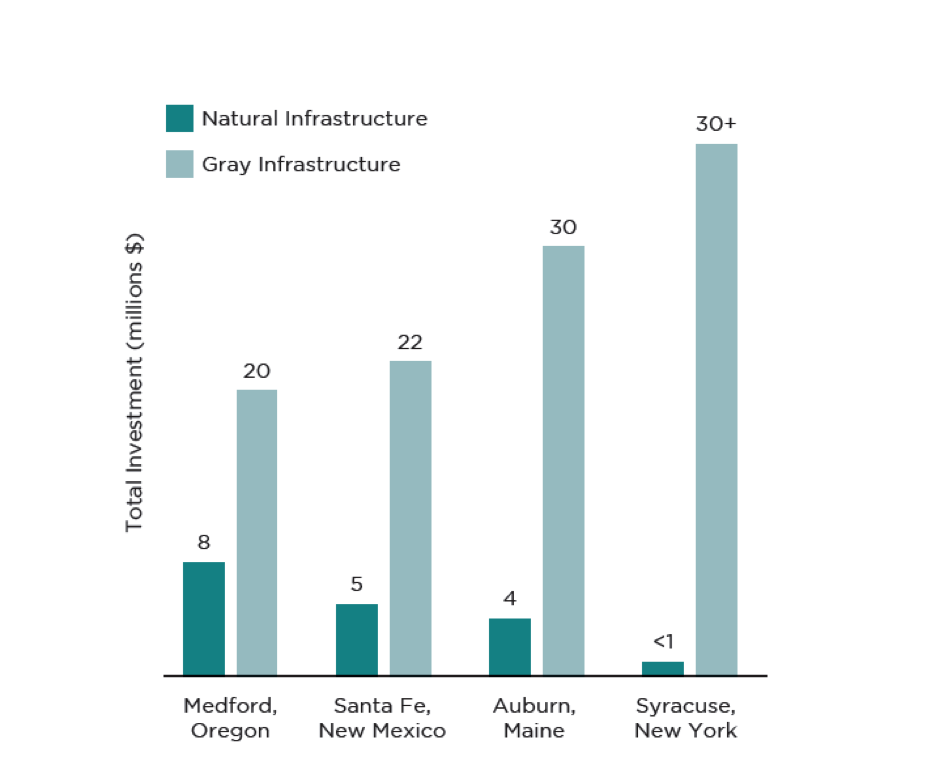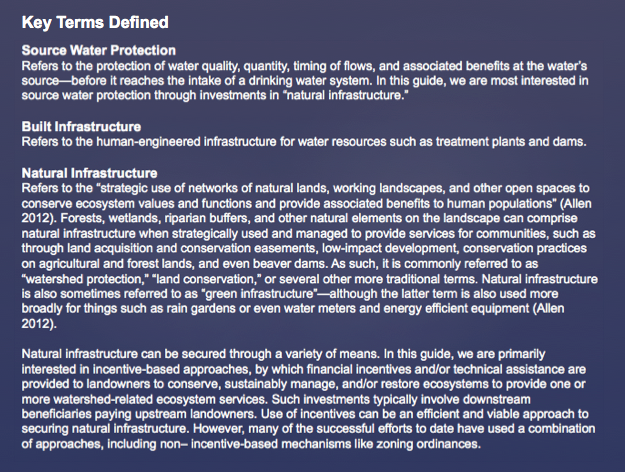From Gray to Green, Investing in Natural Infrastructure to Address Water, Food and Energy Nexus* Challenges
Recent extreme droughts and floods have forced an evaluation of how water infrastructure impacts other sectors, highlighting the need for a multi-disciplinary, cross-sectoral approach to balance environmental, social and economic concerns against a backdrop of climate change.
Investing in natural infrastructure to achieve food, water and energy security can be transformational in making water available for agriculture, electricity generation and water supply. The success of natural infrastructure investments depends on partnerships between sectors and the rise of champions to scale up natural infrastructure to make iter en part of the solution for current and future resource challenges.
Conventional engineering approaches to gray infrastructure – traditional, human-made projects such as dams, water treatment plants and the like – have many limitations. Large engineered projects require significant capital for construction, operations and maintenance, and can have devastating effects on the environment. There is often a lack of flexibility in adapting gray infrastructure to uncertainties in climatic or socio-economic conditions; once dams are built, it is extremely difficult – technically and economically – to adapt them to new flow conditions and changing socio-economic demands.
Environmental services can provide a more flexible infrastructure-like function, such as healthy watersheds purifying water or mangroves protecting the shore from extreme storms. Natural infrastructure also helps maintain gray infrastructure: upstream forests help prevent soil erosion that would otherwise sully reservoirs, limiting the space available for water and hindering hydroelectric turbines.
While gray infrastructure is designed for a limited set of functions, natural infrastructure can be integrated into or directly replace traditional engineering solutions while performing other valuable tasks. Agricultural floodplains contain rich soils for food crops, but they can also be used to route floodwaters away from population centres, while simultaneously providing valuable habitat for fish, birds and other species. During dry periods, healthy forest areas and floodplains can store water for irrigation or drinking.
A recent McKinsey report highlights that, at current levels, the global community will invest $10 trillion in water infrastructure between 2013 and 2030. Substituting or complementing traditional gray infrastructure with natural infrastructure could provide an alternative, cost-effective solution while enhancing environmental benefits. Six U.S. cities managed to save up to $6 billion by shifting their investments from water treatment facilities to sustainable watershed management.
Comparison of green versus gray infrastructure costs for cities to meet Water Quality requirements in the United States**
There is increasing awareness of the importance of investing in natural infrastructure, especially from the private sector. Unilever Tea Kenya worked with communities that were clearing forest areas for fuel, which impacted the stream flows and groundwater needed for tea production. The company started growing native tree seedlings and donating them to the surrounding farmers and communities for planting. Between 2001 and 2009, 850,000 trees were planted to help protect regional water supplies.
Nonetheless, there is huge underinvestment in natural infrastructure relative to the scale of the opportunity, cost-effectiveness and current and future risk exposure. The energy and agriculture sectors collectively contributed less than 1 percent of all natural infrastructure investments in 2013, missing opportunities to invest in its cross-sector benefits.
The lack of investment is partly due to a lack of information needed to evaluate and compare natural infrastructure options to business as usual. Green infrastructure can also be more complex than gray infrastructure, due to longer time horizons before ecological benefits are fully recognized, and the need for multi-stakeholder involvement beyond the many downstream beneficiaries.
Addressing these issues, the Natural Infrastructure in the Nexus Dialogue Synthesis report presents case studies and best practices from different countries. It offers concrete examples of successful stories that can inspire local stakeholders to recognise and consider green solutions to solve nexus challenges.
To increase investment and harness the potential of natural infrastructure for the water, energy and food sectors, government, private sector, civil society, financial institutions and academia need to focus on four key priorities: establish enabling conditions; identify opportunities where natural infrastructure makes economic sense; develop a robust body of literature on the business case of investing in natural infrastructure; and integrate natural infrastructure assessments into food, water and energy system design.
Additional contributions from: Katharine Cross and Alice Armaleo, IWA; James Dalton, IUCN
_______________________________________________________________________________________________________________________________
The Natural Infrastructure in the Nexus Dialogue Synthesis is part of a series that highlights best practice, and identifies connections between the multi-sectoral components of the nexus. The papers are designed to be stand-alone documents, but also relate to each other as key thematic areas in the nexus that have been identified from stakeholder discussions during the Nexus Dialogue on Water Infrastructure Solutions (www.waternexussolutions.org) between 2012 and 2015.
The complete set of synthesis papers will be released throughout the remainder of 2015 and includes:
- Clean technology for nexus infrastructure
- Water stewardship and corporate engagement in the nexus
- Influencing pathways of investments for the nexus
- Governance of the nexus
- Learning from the nexus dialogue
To learn more about the Nexus Dialogue on Water Infrastructure Solutions, visit www.waternexussolutions.org
*What is the Nexus?
**Source: Gartner, T., J. Mulligan, R. Schmidt, and J. Gunn. 2013. Natural Infrastructure Investing in Forested Landscapes for Source Water Protection in the United States. World Resources Institute.



